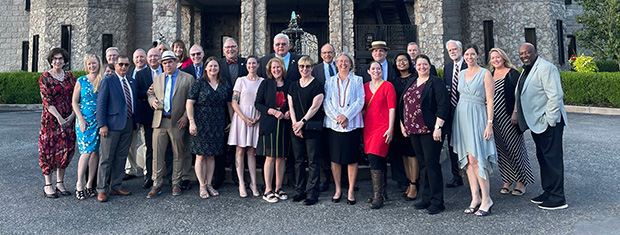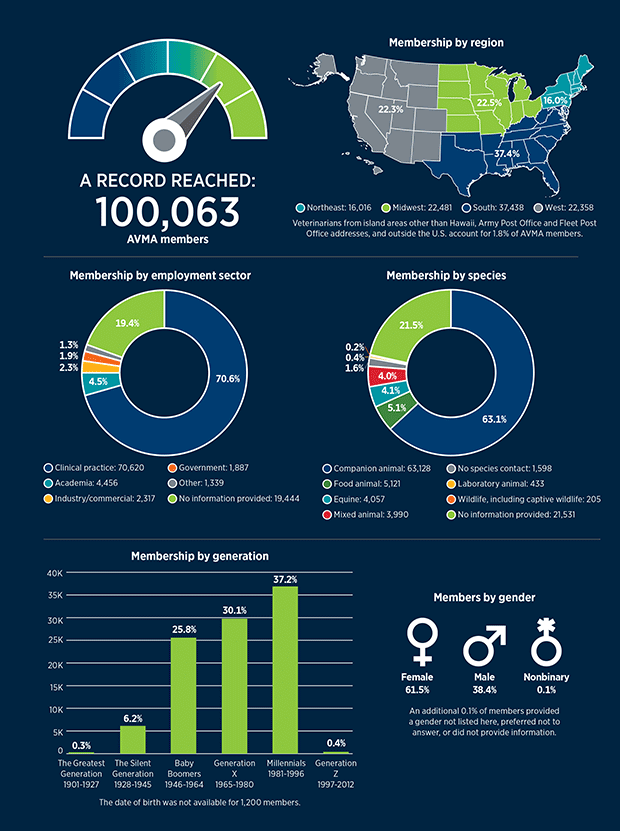
The AVMA has reached a major milestone, recording more than 100,000 members for the first time in its 159-year history. The announcement came during the AVMA Board of Directors’ Sept. 18-20 meeting.
The Association tallied 100,063 members on Sept. 7. The AVMA has grown from having 84,000 members just a decade ago.
The AVMA continues to represent a large majority of U.S. veterinarians, who total 118,624, according to 2020 statistics from the Association.
Dr. Janet Donlin, executive vice president and CEO of the AVMA, said: “When I reflect on the scientific advancements, education, training, and expert care that have brought us to this day and the dedication, compassion, and service that our members deliver for our patients and clients on a daily basis, I see an innovative and ethically grounded profession with an amazing past and a very bright future. As always, we are stronger together!
“We are so immensely grateful for the support and commitment of our members, and we are honored to serve them in all that we do, from policy, resources, tools, and continuing education, to important advocacy work, health care plans, and so much more,” she said.
Dr. Lori Teller, AVMA president, said the milestone says a lot about the AVMA’s efforts to meet the needs of the profession.
“I think the AVMA’s volunteer leaders and staff have made a concerted effort to provide information and resources to our members and stakeholders that are useful and actionable,” she said.
AVMA members receive numerous benefits to help them in their careers, including the following:
- Guidance on public policy issues that impact animal welfare and the profession.
- Discounted rates for the AVMA Convention as well as AVMA symposia and summits.
- Free or discounted access to AVMA economic, salary, and employment data for the profession.
- Subscriptions to JAVMA and open access to AJVR.
- Use of the AVMA Veterinary Career Center.
- Online continuing education and certificate programs.
- Educational materials for clients.
- Access to professional liability and other insurance through PLIT.
- Access to life, disability, and other insurance through AVMA Life.
Then there is the work done on behalf of members, particularly when it comes to advocating at the federal level on matters that are critical to the veterinary community.
For example, the AVMA hosted its annual legislative fly-in this past April. Representing 49 states and 20 veterinary schools, participants urged congressional offices to support and pass the Veterinary Medicine Loan Repayment Program Enhancement Act and the Healthy Dog Importation Act. These pieces of legislation would increase access to veterinary services in underserved rural areas and reduce the risk of the spread of diseases by improving dog importation standards, respectively.
“The AVMA also knows when to take the long view,” Dr. Teller said. “For instance, we are currently working on the workforce challenges facing the profession, including doing research and modeling to make sure any substantive changes that are implemented will help the profession now and in the years ahead. This is a reflection of our commitment to protect, promote, and advance the veterinary profession.”
Back in Time
The AVMA has come a long way from when it was founded in June 1863 by leaders of the American Veterinary Association. They had voted to meet in New York City with colleagues who were interested in removing the nation’s veterinary profession from the grasp of those without sufficient training and education, according to the book “The AVMA: 150 Years of Education, Science, and Service.”
The United States Veterinary Medical Association—which became the AVMA in September 1898—had 39 founding members: 13 in New York state, nine in New Jersey, eight in Massachusetts, six in Pennsylvania, and one each in Delaware, Maine, and Ohio.
The founding members agreed to admit, after oral examination, any “veterinary practitioner” or student of three years’ standing in the profession who had documents and testimonials related to their qualifications, Dr. J. Fred Smithcors wrote in his 1963 book, “The American Veterinary Profession.” By contrast, admission to the AVMA in 1913 required graduation from a school with at least a three-year program and references from two active members. Today, anyone who has earned a professional degree in veterinary medicine from a school or college of veterinary medicine is eligible to join.
U.S. census archives indicate about 1,200 people claimed to be veterinary surgeons in 1870. By 1900, about 8,100 men and 14 women claimed to be veterinary surgeons, although those figures include many individuals without formal training. The AVMA had nearly 400 members then and accredited 19 schools. The AVMA Council on Education, the accrediting body for veterinary programs, now accredits 33 veterinary colleges in the U.S., five in Canada, and 16 internationally.
The AVMA had grown to include 1,650 members by its 50th anniversary in 1913. In 1920, AVMA leaders indicated that of the nearly 13,500 veterinary surgeons in the country, only about 8,000 were considered eligible for membership, and only about 4,100 had become members, JAVMA archives state. The AVMA membership exceeded 20,000 in 1969, ending the year with about 20,200 members. They included about 19,500 of the 26,000 U.S. veterinarians, 580 Canadian veterinarians, and 200 veterinarians from other countries. AVMA membership hit the 30,000 mark in 1978 and 40,000 in 1984.
Changing Roles
In 1931, an AVMA Committee on Education survey of 608 practitioners showed that about 38% of the veterinarians’ time was devoted to cattle, 24% to small animals, 19% to horses, 14% to swine, 3% to poultry, and 2% to sheep, according to Dr. Smithcors’ book. About 17% of veterinarians in the U.S. had federal or state jobs, 1% worked for the Army, and 2% each held teaching, commercial, or municipal jobs.
In a 1938 speech to members, AVMA President Oscar V. Brumley pointed out that since the USVMA had been formed, the profession had established a veterinary education system, become indispensable to livestock owners, helped develop sanitary sciences, and started public health programs. A year later, AVMA President Henry D. Bergman would describe the AVMA as “the sole protection of every individual veterinarian in this country.”
By 1986, about 51% of AVMA members would work primarily or entirely in small animal practice, representing the majority of AVMA members for the first time.
“The Great Convener”
The AVMA has grown and evolved over decades, working always to serve its members. Dr. Teller said she’s proud of how the Association has been able to walk hand in hand with members through a variety of transitions.
“Most of our current members can’t remember when society transitioned from horse-and-buggy days to automobiles, and the profession transitioned as well,” she said. “The AVMA was there for its members then, and now, as we increasingly incorporate technology into our practices, the AVMA is here to help veterinarians utilize technology appropriately, not be replaced by it.”
Dr. Teller added that she’s proud of the AVMA’s ability and willingness to collaborate with others. That includes the Coalition for Connected Veterinary Care, which is intended to help veterinarians integrate telehealth into their practices, with founding members being the AVMA, Veterinary Study Groups, and Merck Animal Health.
Another initiative, the recently launched Journey for Teams initiative, is intended to help veterinary workplaces become more diverse, equitable, and inclusive, in conjunction with the Veterinary Medical Association Executives.
In addition, the first Suicide Prevention Roundtable was convened last year by the AVMA, American Association of Veterinary Medical Colleges, and American Foundation for Suicide Prevention. The AVMA offers a number of well-being and suicide prevention resources, such as suicide prevention training.
“The veterinary profession is vibrant because people can do a variety of things with a veterinary degree, and a diversity of opinions allows the AVMA to continue to be relevant,” Dr. Teller said. “The AVMA is known as the great convener because we are able to bring together people from diverse backgrounds to work together to find real solutions to problems that everyone can utilize.”









